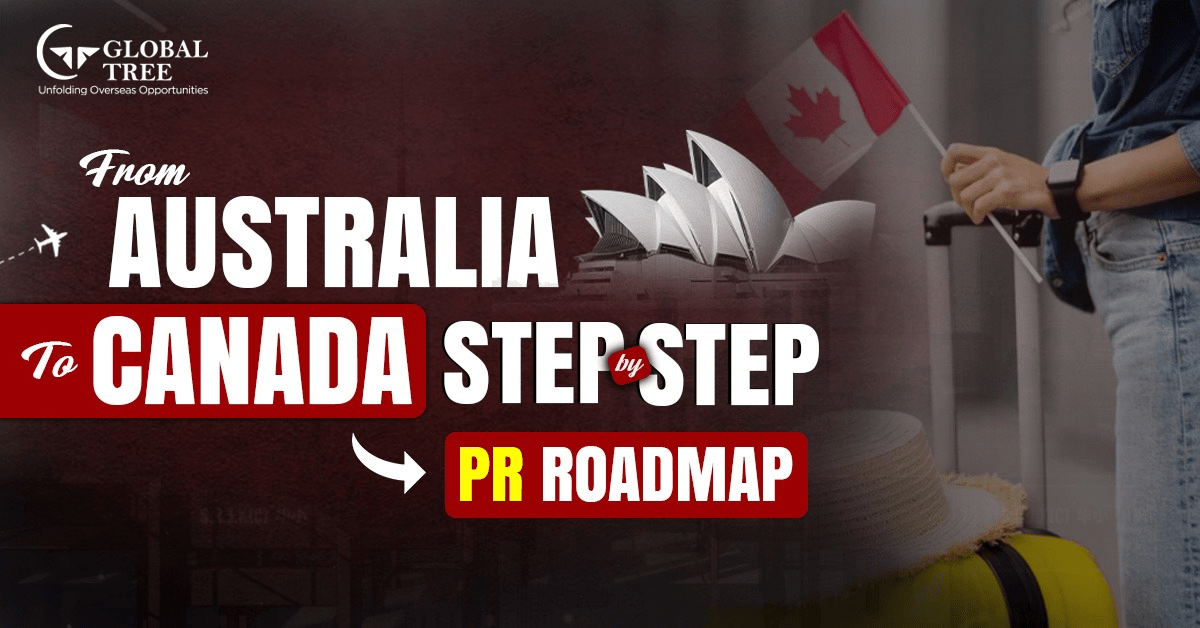Apply for Canada PR from Australia with Expert Guidance

Introduction
If you're an Australian citizen thinking about moving to Canada and want to apply for permanent residency, you may be overwhelmed by the whole process. It may not seem easy, but with proper guidance and solid information, it's doable—and can even be a smooth journey. There are a few key steps involved, such as determining your eligibility and organizing all your documents. This blog shares helpful tips and straightforward advice on confidently applying for Canadian PR from Australia. Keep reading for expert insights and practical guidance to help turn your dream of living in Canada into reality.
Overview of Canadas Permanent Residency (PR) Programs
Canada provides a variety of routes for Australians to become permanent residents, similar to the options available for people from other countries. Since Australians share a common language, have strong educational backgrounds, and often relevant work experience, they usually find the immigration process to Canada to be relatively smooth and straightforward.
Here's a quick look at the main pathways Australians can take to immigrate to Canada:
1. Canada's Express Entry System
Between January and July 2025, Canada invited more than 20,000 people through its Express Entry process. In draws focused on specific categories, French-speaking applicants received invites with CRS scores as low as 410, while open general draws saw success with scores dropping down to 379. Having strong English skills and a degree from Australia generally helps applicants improve their chances of ranking higher on the CRS scale.
2. Provincial Nominee Program (PNP)
In 2024, Canada issued over 89,000 provincial nominations, with Ontario leading the way by offering nearly 45,000 invitations. For 2025, the overall provincial nomination spots are expected to decrease to around 55,000 across the country. Australians who have a job offer or possess skills that are in high demand might find it easier to fast-track their permanent residence through either the Express Entry-linked streams or direct PNP pathways.
3. Pathway from Study to Work to Permanent Residency (PGWP → CEC)
By the end of 2024, Canada had approximately 1 million international students studying there. Australian graduates can apply for a Post-Graduation Work Permit (PGWP), which can last up to three years, giving them time to gather work experience. During this period, they become eligible to apply for permanent residency through the Canadian Experience Class (CEC).
4. Family Sponsorship Opportunities
In 2024, Canada welcomed over 483,000 new permanent residents, a large part of whom came through family sponsorship programs. The target for 2025 is about 395,000 PRs, emphasizing Canada's continued focus on family reunification. Australians with family members who are Canadian citizens or permanent residents can apply through the Canada Dependent Visa program to sponsor spouses, children, parents, or grandparents, making this a steady and straightforward way to settle in Canada.
5. Atlantic Immigration Program (AIP)
The AIP is personalized for skilled workers and recent graduates who want to settle in one of Canada's four Atlantic provinces. Although the exact number of people accepted each year isn't always shared publicly, the program has traditionally aimed to admit around 6,000 newcomers annually. Australians with job offers from designated employers in these regions might qualify directly through this pathway.
6. Rural and Northern Immigration Pilot (RNIP)
The RNIP provides a route to permanent residency for skilled workers willing to live in specific rural communities. To qualify, applicants need a full-time, non-seasonal job offer from a participating community. While exact stats on nominations are not available, it's considered a good option for Australians hoping to settle long-term outside of big cities.
7. Quebec's Immigration Programs (QSWP & PEQ)
Quebec manages its immigration system, separate from Canada's federal programs, and does not take part in Express Entry. Through the Quebec Skilled Worker Program (QSWP) and Quebec Experience Program (PEQ), Australians who have French language skills or Quebec work or study experience may be eligible. Quebec sets its immigration targets, but yearly figures are generally not shared at the national level.
Eligibility Requirements for Canadian Permanent Residency for Australian Applicants
Here's a clear overview of what Australian applicants need to know about becoming a Canadian permanent resident, focusing on the main immigration options. Although being Australian doesn't give you a special edge when it comes to PR visa services, your good English skills, solid educational background, and work experience in skilled jobs often make the process smoother and more straightforward.
1. Express Entry – Federal Skilled Worker Program (FSWP)
| Requirement | Details |
|---|---|
|
Work Experience |
1 year (within last 10 years) in a skilled occupation (NOC TEER 0, 1, 2, or 3) |
|
Language Proficiency |
IELTS or CELPIP – CLB 7 minimum (English) |
|
Education |
Equivalent to a Canadian secondary or post-secondary credential (ECA needed) |
|
Age |
No strict limit, but the best points are between 20 and 35 years. |
|
Points Score |
Minimum 67 out of 100 on FSWP points grid |
|
Proof of Funds |
Required unless you have a valid Canadian job offer or are applying under CEC |
2. Canadian Experience Class (CEC)
| Requirement | Details |
|---|---|
|
Canadian Work Experience |
1 year of skilled full-time (or equivalent part-time) work in Canada |
|
Language Proficiency |
CLB 7 for NOC 0 or 1 jobs; CLB 5 for NOC 2 or 3 |
|
Education |
No minimum, but having Canadian or equivalent education helps CRS score |
|
Proof of Funds |
Not required |
Note: This is ideal for Australians who study and work in Canada (PGWP route).
[Find out More: Dreaming of Australia? Here’s How to Secure Your PR]
3. Provincial Nominee Program (PNP)
| Requirement | Details |
|---|---|
|
Job Offer |
Often required (varies by province and stream) |
|
Work Experience |
Relevant to the province’s labor market needs |
|
Language Proficiency |
Varies (often CLB 6–7) |
|
Intent to Reside |
Must settle in the nominating province |
|
Education |
Post-secondary diploma or degree often required |
Australians in occupations like healthcare, trades, and tech may benefit from PNPs.
4. Family Sponsorship
| Requirement | Details |
|---|---|
|
Relationship to Sponsor |
Spouse, common-law partner, parent, grandparent, or dependent child |
|
Sponsor Eligibility |
Must be a Canadian PR or citizen, aged 18+, financially stable |
|
Income Requirements |
Especially relevant for parent/grandparent sponsorships |
|
Genuine Relationship Proof |
Required for spouses/partners |
5. Study → PGWP → PR Pathway
| Stage | Eligibility Criteria |
|---|---|
|
Study Permit |
Accepted into a designated learning institution (DLI) in Canada |
|
PGWP |
Graduate of eligible full-time program (min. 8 months) |
|
CEC Eligibility |
1 year Canadian work experience in a skilled job under PGWP |
|
Language Proficiency |
CLB 7 or above (English) |
This is a popular pathway among young Australians aiming for long-term PR.
[Discover More: Study in Australia: Everything You Must Know Before You Go]
6. Atlantic Immigration Program (AIP)
| Requirement | Details |
|---|---|
|
Job Offer |
From a designated employer in Atlantic Canada |
|
Language Proficiency |
CLB 4 or above |
|
Education |
Post-secondary (ECA required for foreign degrees) |
|
Work Experience |
1 year in a related skilled occupation |
7. Rural and Northern Immigration Pilot (RNIP)
| Requirement | Details |
|---|---|
|
Job Offer |
Full-time, non-seasonal from a participating rural community |
|
Work Experience |
1 year in the last 3 years |
|
Language Proficiency |
CLB 4 to 6 depending on job type |
|
Education |
At least Canadian high school equivalent (ECA required) |
8. Quebec Immigration (QSWP & PEQ)
| Requirement | Details |
|---|---|
|
French Proficiency |
Required for most Quebec programs (especially PEQ) |
|
Education/Work Experience |
Must meet Quebec’s selection criteria (points system used) |
|
Intent to Reside in Quebec |
Must be clearly demonstrated |
Australians with French skills can explore Quebec’s unique pathways.
Step-by-Step Guide to Submitting a Canada PR Application from Australia
Here's a straightforward guide to understanding the eligibility criteria for Canadian Permanent Residency (PR) specifically customized for Australians, covering the main immigration pathways. While being Australian doesn't automatically give you an edge in the PR process, your strong English skills, good educational background, and relevant work experience often match well with Canada's immigration requirements.
1. Start by Checking if You're Eligible
First, determine which PR route best suits your profile—whether that's Express Entry for Canada, a Provincial Nominee Program (PNP), family sponsorship, or another option. Take a good look at your education, work history, age, and language skills. Doing this early helps you pick the right program and understand what's needed before you get too deep into the process.
2. Take a Language Test (IELTS or CELPIP)
You'll need to demonstrate your English abilities by taking either the IELTS General Training or CELPIP test. Most immigration streams require at least a Canadian Language Benchmark (CLB) 7. Remember that your test results are valid for two years, so make sure to plan so your results are recent and meet the minimum score for your chosen pathway.
3. Get Your Educational Qualifications Assessed (ECA)
Have your Australian degrees or diplomas evaluated by designated authorities recognized by Canada to verify their Canadian equivalents. This step confirms that your qualifications meet Canadian standards for immigration purposes. It usually takes about 4 to 8 weeks, so it's smart to start this early to keep your application on track.
4. Create an Express Entry Profile
Complete an online profile with details such as your language test scores, education, work experience, and personal information. Based on these details, the system calculates your Comprehensive Ranking System (CRS) score. Your profile remains active for 12 months, placing you in the pool of candidates.
5. Boost Your CRS Score if Needed
If your score isn't high enough to get noticed during draw times, consider retaking language tests, gaining more work experience, pursuing additional education, or applying for a provincial nomination, which adds a hefty 600 points. Having a valid job offer from Canada can also improve your chances.
6. Receive an Invitation to Apply (ITA)
If your CRS score matches or exceeds the latest cut-off, Immigration, Refugees and Citizenship Canada (IRCC) will send you an ITA. You'll have 60 days to submit your complete application along with all supporting documents. Missing this window means you lose your spot and will need to reapply.
7. Submit Your Complete PR Application
Prepare and upload all required documents for PR for Canada, including police clearances, medical exams, proof of funds, letters from employers, and passports. Pay the applicable fees—about CAD 1,365 for a single applicant. Double-check everything to avoid missing papers that could cause delays or rejection.
8. Attend Your Biometrics Appointment
Once your application is in, you'll receive a Biometric Instruction Letter. Schedule an appointment at a nearby Visa Application Centre in Australia to give your fingerprints and photos. Biometrics are valid for 10 years and are an essential step to move your application forward.
9. Wait for Processing and Final Decision
The average processing time is between 6 and 9 months. The authorities might request additional information or documents during this period. Be prompt in your responses. Once approved, you'll get a Confirmation of Permanent Residence (COPR) and, if needed, a PR visa to travel.
Conclusion
Getting your Canadian Permanent Residency from Australia might seem complicated at first, but it's doable, especially for skilled workers, grads, and families. If you have good English skills, a recognized education, and relevant work experience, you're in a strong position to make it happen. Just take it step by step—from checking your eligibility to finally arriving in Canada—you can make the whole process smoother. Whether you're applying through Express Entry, a provincial program, or after studying in Canada, there are plenty of different pathways designed to match different backgrounds. With careful planning and timely action, turning your dream of living in Canada into reality becomes much more manageable.
[Learn More: From PR to Australian Citizen: What Changes for You?]
Frequently Asked Questions
1. Can Australians apply for Canada PR through Express Entry?
Yes, Australians are fully eligible to apply for Canadian PR through the Express Entry system. You must meet the criteria under one of the Express Entry-managed programs, such as the Federal Skilled Worker Program. With strong English skills and recognized education, many Australians score competitively on the CRS scale.
2. Do I need a job offer to apply for Canada PR from Australia?
A job offer is not mandatory for Express Entry, but it can boost your CRS score by up to 200 points. Some Provincial Nominee Programs (PNPs), however, may require a job offer. Having a Canadian job offer strengthens your chances, but it isn't essential for most PR pathways.
3. How long does the Canada PR process take from Australia?
The total processing time varies, but generally takes 6 to 9 months after receiving an Invitation to Apply (ITA). Preparation steps like ECA and IELTS can take an additional 2 to 3 months. Starting early and submitting a complete application helps avoid unnecessary delays.
4. Is IELTS mandatory for Australian applicants?
Yes, IELTS or CELPIP (General) is mandatory to prove language proficiency, even for native English speakers. Most PR programs require CLB 7 or higher. IELTS General Training is the most commonly accepted version for immigration purposes.
5. Can I include my family in the PR application?
Yes, you can include your spouse/common-law partner and dependent children in your PR application. Each additional family member increases the required proof of funds. Your spouse's qualifications may also improve your CRS score if included.
6. What is the cost of applying for Canada PR from Australia?
The total cost is approximately CAD 1,365 for a single applicant, including the right of permanent residence fee. Additional costs apply for your spouse and children. You should also budget for IELTS, ECA, police checks, biometrics, and medical exams.
7. Do Australian degrees need to be assessed for PR?
Yes, an Educational Credential Assessment (ECA) is required to prove that your Australian degree meets Canadian standards. This is mandatory for Express Entry unless you studied in Canada. The ECA helps calculate your CRS score accurately.
8. Can I apply for PR while living in Australia?
Yes, the entire PR process can be completed online from Australia, including profile creation, document submission, and biometrics. You only need to travel to Canada once your application is approved and you receive your Confirmation of Permanent Residence (COPR). There's no requirement to visit Canada before applying.
9. What is the minimum CRS score for Express Entry?
CRS cut-offs fluctuate with each draw and by category. In 2025, general draws have had cut-offs ranging from 379 to 550, depending on the stream. A higher CRS score increases your chance of receiving an ITA quickly.
10. Is Canadian PR permanent for life?
Canadian PR is valid indefinitely, but the PR card must be renewed every 5 years. To maintain status, you must live in Canada for at least 730 days (2 years) every 5 years. After meeting residency and language requirements, you may apply for citizenship.





